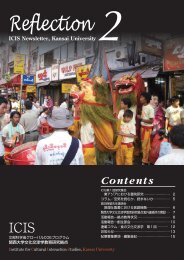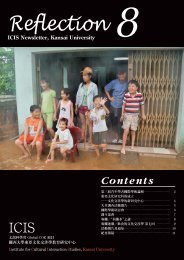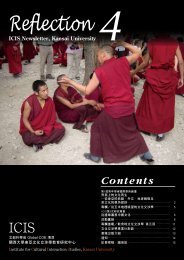English
English
English
Create successful ePaper yourself
Turn your PDF publications into a flip-book with our unique Google optimized e-Paper software.
The First International Academic Forum for the Next Generation<br />
Cultural Reproduction on its Interface<br />
Chinese on the Internet: Case of Wikipedia’s Chinese<br />
HINO Yoshihiro (COE-DAC, ICIS, Kansai University)<br />
Wikipedia was originally published in<br />
<strong>English</strong>, which was then translated into<br />
different languages. Also, each region uses<br />
similar native concepts as the base and<br />
modifies the information on their own. In the<br />
case of the Chinese language, there are<br />
differences between simplified Chinese and<br />
traditional Chinese, as well as different vocabularies among different<br />
regions. Linguistic contact can be revealed by comparing articles<br />
written in different regions.<br />
Comments<br />
HORIIKE Nobuo<br />
(School of Humanities and Culture, University of Tsukuba)<br />
The three presentations are relevant to<br />
the three major foreign cultures (Buddhism,<br />
Islam, and modern civilization)that had<br />
great influences on Chinese culture. When<br />
a culture accepts another one, translation<br />
plays an important role at the forefront of<br />
all. Cultural interaction is unattainable<br />
without translation. Translation is associated with misunderstanding<br />
and misinterpretation, but it creates new life force and energy at the<br />
same time.<br />
< Session 4 ><br />
Tea Viewed from the Comparative<br />
Culture and Cultural Interaction<br />
Cultural Context of the Tea Viewed from the Comparison<br />
Study in of East Asia<br />
NISHIMURA Masanari (COE Assistant Professor, ICIS Kansai<br />
University), OTSUKI Yoko (COE-RA, ICIS, Kansai University),<br />
and Kansai University ICIS youth research group<br />
Tea drinking has a long history in the<br />
culture of East Asian areas. The universality<br />
and peculiarity of the tea culture are<br />
observed by comparing and examining the<br />
spread of tea and its transition, languages<br />
that are used for tea in proverbs and old<br />
phrases associated with tea, cultural response<br />
to the first introduction of tea drinking, formalities and religion, and<br />
it’s association with women. As a valid view of the study of cultural<br />
comparison, differences in the cultures of tea drinking between Korea<br />
and Japan, and different responses toward women’s behavior on tea<br />
drinking between China and Western Europe are discussed.<br />
Development of Porcelain Tea Ware in Europe: From Hizen’s<br />
Porcelain Tea Ware to European Porcelain Tea Service<br />
SAKURABA Misaki<br />
(Kakiemon-style Ceramic Art Research Center, Kyushu Sangyo University)<br />
In the 17th century, porcelain tea ware were<br />
imported from the Orient to Europe, while royalty<br />
and noblemen used them as a display of financial<br />
power and as sophistication for interior decoration<br />
and tableware called service. After the 18th<br />
century, when European could produce porcelains,<br />
tea ware were created in different designs to suit<br />
their taste, and tea drinking became a common habit in Europe.<br />
The Commoditization of Tea Leaf in the Southwest Area<br />
of Yunnan, Province of China: The Instance of Pu’er and<br />
Sipsong Panna in Qing Era<br />
MASUDA Atsushi(Research Institute for Humanities, Gakushuin University)<br />
Tea cultivated in Simao and Sipsong Panna<br />
on the southern part of Yunnan was popular<br />
due to the immigration of the Han Chinese into<br />
Yunnan and the establishment of tea brewing<br />
methods. Exports of Pu’er tea to the north of<br />
Yunnan started during the Qing era and caused<br />
the advancement of the Han Chinese<br />
merchants who tried to trade tea, resulting in the intervention by the<br />
Qing Dynasty. The situation caused conflicts with ethnic minority<br />
groups, which eventually resulted in transformation of the ecosystem.<br />
Comments<br />
TSUNOYAMA Sakae (Former Director of Sakai City Museum,<br />
Professor Emeritus of University of Wakayama)<br />
Tea is the only article of taste that originated<br />
in Asia. Missionaries who visited Japan were<br />
impressed by the “culture of courtesy” in tea<br />
drinking, which influenced European and later<br />
arose the longing for Asia, such as Chinoiserie.<br />
It is also noteworthy that women in England<br />
drank tea along with a luxurious breakfast.<br />
Overall comments<br />
WANG Zhenping (Humanities and Social Studies Education,<br />
Nanyang Technological University, Singapore)<br />
There was a wide variety of reports. In particular, the discussions<br />
of diplomacy and cultural interaction in the first session raised the<br />
limit of the existing theoretical definitions, such as diplomacy, and<br />
the necessity of reevaluating them through<br />
the perspective of cultural interaction. The<br />
accumulation of empirical studies on cultural<br />
reproduction based on the fluidity and<br />
multilayered nature of boundaries and<br />
decentralizing inclination are also important<br />
in understanding the modern world.<br />
4












